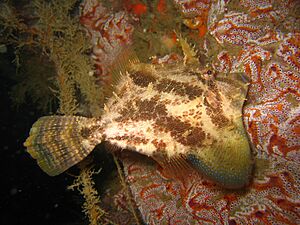Fan-bellied leatherjacket facts for kids
Quick facts for kids Fan-bellied leatherjacket |
|
|---|---|
 |
|
| Scientific classification | |
| Synonyms | |
|
The fan-bellied leatherjacket (Monacanthus chinensis) is a type of filefish. It is also called the fantail leatherjacket. You can find this fish in the western Pacific Ocean and the eastern Indian Ocean. It lives near reefs and soft, muddy areas in shallow water. This fish can grow to be about 40 centimeters (16 inches) long.
What Does It Look Like?
The fan-bellied leatherjacket can grow up to about 40 centimeters (16 inches) long. It has a flat body from side to side. You can easily spot it by its snout, which points upwards. It also has a special tail fin that looks like a fan with a long, thin extension.
Another unique feature is a large flap of skin under its body. This is called a dewlap. The first dorsal fin (the one on its back) has a long, stiff spine that can stand up. Behind it is a shorter spine. The second dorsal fin has 28 to 34 soft rays, and its anal fin has 27 to 34 soft rays.
The color of this fish can change! It depends on where it lives. If it swims over beds of mussels, it might be dark. But if it's over a sandy seabed, it can be cream or tan. No matter the color, it usually has darker spots and lines that are not regular.
Where Does It Live?
The fan-bellied leatherjacket lives in the Indo-Pacific region. Its home range stretches from Malaysia and southern Japan. It also lives through Indonesia and Samoa, all the way to western, northern, and eastern Australia.
This fish is a bottom-dwelling species. This means it spends most of its time near the seabed. You can find it in estuaries (where rivers meet the sea) and along rocky coasts covered in algae. It also lives over muddy and silty seabeds. You might see it in seagrass meadows and on reefs, both close to shore and further out. It can live in waters up to about 50 meters (164 feet) deep.
What Does It Eat?
The fan-bellied leatherjacket is active during the day. It is an omnivore, meaning it eats both plants and animals. It seems to find its food by sight.
It eats algae and seagrass. But it also preys on small animals without backbones. These include tiny shrimp-like creatures called amphipods. It also eats small shrimp, copepods, and tanaids. Other snacks include bryozoans (tiny colonial animals), hydroids, polychaete worms, and tunicates (sea squirts).
Even though it eats seagrass and algae, it doesn't seem to digest them very well. However, it still gets many important nutrients from these plants. About 40% of its diet is animal matter. This fish really depends on the tiny creatures and plants that grow on seagrass and other surfaces in its habitat.

